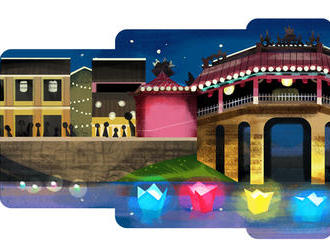Monitorujeme 1696 zdrojov

 Google Dooles 15.07.2019 19:34
Date: July 16, 2019
By the light of the full moon, residents of the town burn incense and light small lanterns, floating them on the river until hundreds of colorful lanterns illuminate the water. During the full moon season with which the HŠĽôi An’s lantern festival aligns, today’s Doodle celebrates a historic town that’s remained largely unchanged for several centuries.
Situated on the north bank of Vietnam’s scenic Thu Bon River, right where it empties into the South China Sea, HŠĽôi An was one of the busiest trading ports in Southeast Asia from the 15th to the 19th century.
While the name HŠĽôi An means “peaceful meeting place,” the seaport has been abuzz with activity since the 2nd century. The surrounding area, known as QuŠļ£ng Nam province, produced cinnamon and ginseng, as well as textiles and ceramics, enticing traders from all over Asia and Europe. By the 1600s, Dutch, Portuguese, Spanish, Indian, Filipino, Indonesian, Thai, French, British, and American ships would come and go, while Chinese and Japanese traders rented waterfront houses in the seaside town.
Business tapered off when silt accumulation in the river made it difficult for larger ships to navigate. Fortunately, the city was spared from modernization for over 200 years, leaving the original street plan and buildings intact.
In 1999, HŠĽôi An was designated a World Heritage Site by UNESCO. Seventeenth-century Japanese traders built the lacquered wood Chùa CŠļßu, or “Bridge Pagoda,” with entrances guarded by statues of monkeys and dogs. Hundreds of timber-frame buildings and Chinese temples line narrow streets that are now popular with sightseers, historians, and filmmakers, seeking to experience and recapture a bygone era.
Early concepts by artist Shanti Rittgers
Location:
Tags:
,
,
,
,
,
,
,
,
,
Google Dooles 15.07.2019 19:34
Date: July 16, 2019
By the light of the full moon, residents of the town burn incense and light small lanterns, floating them on the river until hundreds of colorful lanterns illuminate the water. During the full moon season with which the HŠĽôi An’s lantern festival aligns, today’s Doodle celebrates a historic town that’s remained largely unchanged for several centuries.
Situated on the north bank of Vietnam’s scenic Thu Bon River, right where it empties into the South China Sea, HŠĽôi An was one of the busiest trading ports in Southeast Asia from the 15th to the 19th century.
While the name HŠĽôi An means “peaceful meeting place,” the seaport has been abuzz with activity since the 2nd century. The surrounding area, known as QuŠļ£ng Nam province, produced cinnamon and ginseng, as well as textiles and ceramics, enticing traders from all over Asia and Europe. By the 1600s, Dutch, Portuguese, Spanish, Indian, Filipino, Indonesian, Thai, French, British, and American ships would come and go, while Chinese and Japanese traders rented waterfront houses in the seaside town.
Business tapered off when silt accumulation in the river made it difficult for larger ships to navigate. Fortunately, the city was spared from modernization for over 200 years, leaving the original street plan and buildings intact.
In 1999, HŠĽôi An was designated a World Heritage Site by UNESCO. Seventeenth-century Japanese traders built the lacquered wood Chùa CŠļßu, or “Bridge Pagoda,” with entrances guarded by statues of monkeys and dogs. Hundreds of timber-frame buildings and Chinese temples line narrow streets that are now popular with sightseers, historians, and filmmakers, seeking to experience and recapture a bygone era.
Early concepts by artist Shanti Rittgers
Location:
Tags:
,
,
,
,
,
,
,
,
,
NEWS.SK odpor√ļńća
Nie s√ļ n√°jden√© Ňĺiadne ńćl√°nky.
Nie s√ļ n√°jden√© Ňĺiadne ńćl√°nky.
























